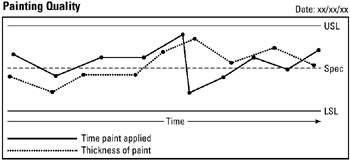Tool 114: Multivariable Chart
| AKA | Multi-Var Chart |
| Classification | Analyzing/Trending (AT) |
Tool description
A multivariable chart is used to measure time-series data of multiple variables reflecting process capability variance. This chart provides process variable correlation and interaction information that is not usually found when examining traditional control charts one at a time.
Typical application
-
To construct an overlay of certain process variables normally recorded on control charts.
-
To allow time-series analysis of process variables.
-
To identify possible problem causes.
-
To contribute to design of experiments (DOE) and statistical process control (SPC) activities.
Problem-solving phase
| → | Select and define problem or opportunity |
| → | Identify and analyze causes or potential change |
| Develop and plan possible solutions or change | |
| Implement and evaluate solution or change | |
| Measure and report solution or change results | |
| Recognize and reward team efforts |
Typically used by
| 1 | Research/statistics |
| Creativity/innovation | |
| 3 | Engineering |
| Project management | |
| 2 | Manufacturing |
| Marketing/sales | |
| Administration/documentation | |
| Servicing/support | |
| 4 | Customer/quality metrics |
| Change management |
befor
-
Control Chart
-
Data Collection Strategy
-
Checksheet
-
Checklist
-
Standard Deviation
after
-
Variance Analysis
-
Process Capability Ratios
-
Analysis of Variance
-
Potential Problem Analysis (PPA)
-
Trend Analysis
Notes and key points
-
Note that it is difficult plotting process variables along matching time spans. Also, scaling of upper and lower specification limits (USL-LSL) for process variables may be limited to the base variable with the greatest upper and lower deviation from the specification target value.
Step-by-step procedure
-
STEP 1 First, acquire the target and upper and lower specifiction values from design engineering, manufacturing, or the quality department.
-
STEP 2 Identify two to four related process variables. See example Painting Quality.
-
STEP 3 Draw a chart, with the center line labeled spec (target) value and upper and lower horizontal lines designated USL and LSL respectively.
-
STEP 4 Designate the x-axis with the proper time scale. The x-axis represents an amount of time for the variable with the longest time span.
-
STEP 5 Identify process variables and encode for plotting and analysis purposes.
-
STEP 6 Take measurements and plot by connecting data points.
-
STEP 7 Date the chart and keep for later reference.
Example of tool application

EAN: 2147483647
Pages: 326